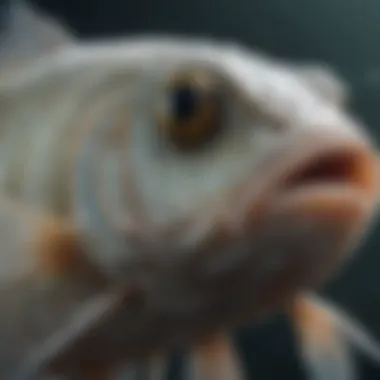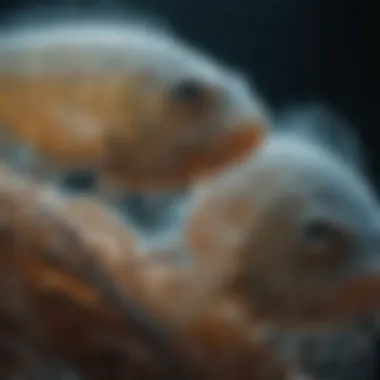Understanding Fish Lice: Impacts and Management Strategies


Intro
Fish lice are parasitic organisms that belong to the order of crustaceans. They inhabit the bodies of several fish species, causing various health issues. The implications of fish lice extend beyond individual fish health; they also affect aquatic ecosystems and aquaculture practices. Understanding fish lice is crucial for maintaining fish populations and ensuring the stability of ecosystems where these organisms are prevalent.
In this overview, we will delve into the biological characteristics of fish lice, their life cycles, and their effects on fish. Furthermore, we will explore effective management strategies to control their populations, particularly in aquaculture settings. This foundational knowledge is essential for educators, researchers, and professionals in the field.
Intro to Fish Lice
Fish lice are integral to the study of aquatic life, yet they often remain obscure in discussions related to marine biology. Understanding these parasites is vital for both ecological balance and aquaculture sustainability. This section elucidates the significance of fish lice and sets the stage for a detailed exploration of their biology and impact.
Definition and Classification
Fish lice, primarily belonging to the subclass Copepoda, are ectoparasitic crustaceans. They are commonly classified into two prominent genera: Argulus and Lernaea. Argulus species are often referred to as "fish lice" due to their widespread presence in freshwater and marine environments. They attach to fish and feed on their skin and blood, causing significant harm. Lernaea, on the other hand, is known as the anchor worm, which embeds itself into the fish's skin. The classification is crucial for understanding their life stages and potential threats to fish health.
Historical Context
Historically, fish lice have been recognized since ancient times, often noted in texts related to fish health. Early fishery practices in various cultures recorded the effects of these parasites on fish mortality and populations. The impact on aquaculture systems began to be properly understood in the 20th century when significant declines were observed in cultured stocks. As fish farming grew, so too did the need for effective management strategies against fish lice infestations. Current research continues to build upon this historical foundation, aiming to develop more sustainable practices that ensure both fish welfare and aquaculture productivity.
Biology of Fish Lice
The study of fish lice is crucial to understanding their impact on fish populations and aquatic ecosystems at large. This section delves into their anatomy, life cycle, and reproductive strategies, revealing aspects that are vital for managing these parasites effectively. Understanding the biology of fish lice can help aquaculture professionals combat infestations and maintain the health of fish stocks. This knowledge is also beneficial for educators and researchers exploring aquatic biology and parasitology.
Anatomy and Physiology
Fish lice, particularly the species from the family Argulidae, exhibit a unique anatomical structure suited for their parasitic lifestyle. They possess a flattened body shape and a pair of large, compound eyes which enhance their ability to detect hosts. Lice also have specialized appendages that facilitate attachment to fish. The mouthparts are adapted for piercing skin and sucking blood, demonstrating their evolutionary adaptations to a parasitic existence.
The physiological processes of fish lice are equally specialized. For instance, they exhibit adaptations to both freshwater and marine environments. They can osmoregulate effectively, allowing them to balance salt and water levels inside their bodies. This ability is crucial for their survival in varying conditions.
Life Cycle Stages
The life cycle of fish lice comprises several distinct stages: egg, larva, juvenile, and adult. Understanding each stage helps in identifying infestation periods and implementing control measures.
- Eggs are typically laid in clusters and attach to fish or aquatic plants.
- Larvae, upon hatching, are free-swimming and seek hosts shortly after.
- Juveniles settle on fish and begin feeding, gradually maturing into adults.
- Adults reproduce, continuing the life cycle.
Each stage presents unique vulnerabilities that can be targeted through management strategies. Control efforts can be most effective when aimed at specific life cycle phases, disrupting reproduction and growth.
Reproductive Strategies
Fish lice demonstrate fascinating reproductive strategies that enhance their survival. Many species are ovoviviparous, meaning they give birth to live young rather than laying eggs. This strategy allows for a quicker population increase, as young lice are ready to attach to hosts shortly after birth.
Additionally, some species exhibit hermaphroditism, possessing both male and female reproductive organs. This can ensure reproduction even in low-density populations, increasing their resilience in changing environments.
In summary, the biology of fish lice offers insight into their survival and the challenges they pose to fish health. Educators, researchers, and fish farmers can use this knowledge to develop more effective management practices.
"Understanding the biology of fish lice is essential for effective control and maintaining healthy aquatic ecosystems."
By grasping the intricate facets of fish lice biology, stakeholders can better prepare for and manage the challenges these parasites present.
Types of Fish Lice
The classification of fish lice is essential for both research and management practices. Understanding the specific types of fish lice helps in identifying their impacts on fish populations, discerning their ecological roles, and applying effective control measures. With numerous species of fish lice, three primary groups stand out: Argulus species, Lernaea species, and other notable types. Each group displays distinct characteristics and behaviors, affecting various fish species differently. This section provides a closer look at these types, their features, and their significance in aquatic ecosystems, helping readers understand the broader implications for fish health and aquaculture.


Argulus Species
Argulus species, commonly known as carp lice, are among the most recognized fish lice. They belong to the family Argulidae, and they are ectoparasites, meaning they inhabit the external surfaces of fish. These species have a distinctive flattened body and are typically green or yellow in color. They attach to their hosts using specialized mouthparts, feeding on blood and tissues.
The impact of Argulus species on fish health can be severe. Infestation leads to noticeable physical signs such as lesions and increased mucus production. Beyond physical damage, there are also behavioral changes. Fish may show signs of distress, like rubbing against surfaces or jumping, attempting to dislodge the parasites.
Lernaea Species
Lernaea species, also known as anchor worms, are another significant group of fish lice. They belong to the family Lernaeidae and can be distinguished by their long, slender bodies that resemble a worm-like structure. Lernaea attaches firmly to fish skin, embedding part of its body beneath the epidermis, which can open the door to secondary infections.
The life cycle of Lernaea is complex. The adult females produce egg sacs, which float in the water until they hatch. The resultant larvae then seek fish hosts. Infested fish can become significantly stressed, and the consequences can include reduced growth rates and increased susceptibility to diseases. Managing Lernaea infestations is crucial in aquaculture to maintain fish health.
Other Notable Types
In addition to Argulus and Lernaea species, several other types of fish lice exist. For instance, the species of the genus Tracheliastes is known for its unique adaptations. They typically inhabit gills, where they feed on the tissues. This lifestyle can lead to suffocation in their hosts, as they directly affect respiration.
It is essential to monitor these lesser-known types for similar consequences as those observed with Argulus and Lernaea. Fish lice can dramatically influence fish populations and their ecological roles. Understanding the range of species present in a habitat can aid in effective management strategies to keep fish healthy in natural and controlled environments.
Impact on Fish Health
Understanding the impact of fish lice on the health of fish is crucial for various stakeholders, including aquaculture professionals and researchers. The presence of fish lice can significantly affect the well-being of fish. This leads to economic losses in aquaculture and can disrupt natural ecosystems.
Symptoms of Infestation
Physical Signs
Fish lice infestations can manifest through several visible indicators. One of the primary signs includes the presence of lesions or wounds on fish skin. These wounds occur as the parasites attach and feed on the host's blood. Fish may also exhibit increased mucus production, which serves as a response to irritation caused by the lice. Another notable characteristic is abnormal behaviors such as fish rubbing against surfaces, a behavior known as flashing. This is significant because it highlights the physical distress experienced by the host fish. Monitoring for these physical signs is vital in managing fish lice and mitigating their impact on health.
"Physical signs offer critical clues that can lead to timely intervention in fish health management."
The unique feature of physical signs lies in their visibility. Fish lice can be difficult to spot until symptoms become pronounced. Early detection based on these signs can help prevent wider infestations and associated health issues.
Behavioral Changes
Behavioral changes in fish are another important aspect of identifying lice infestations. Infected fish often show shifts in feeding patterns; they may eat less due to discomfort or stress. Fish may also isolate themselves from the school, indicating distress. Such changes can impact not only the individual fish but also the dynamics of the entire population. A notable characteristic of these behavioral changes is their potential for rapid development, making it a clear indicator of infestation.
The unique aspect of behavioral changes is that they reveal the psychological impact of fish lice. Stress responses can escalate quickly, leading to weakened immune systems over time. This understanding is beneficial for ongoing research and addressing conditions in aquaculture environments.
Health Consequences
Stress Responses
Stress responses in fish infested with lice can have far-reaching implications. Elevated stress levels can lead to increased cortisol production, negatively affecting immune functions. Fish under stress show a decreased ability to recover from diseases, which can exacerbate the impact of lice infestations. Monitoring stress parameters, like activity levels and feeding, aids in assessing overall fish health. The key characteristic of stress responses is their holistic effect on fish biology, connecting physical health with behavioral aspects.
Recognizing stress responses is critical for timely management decisions. Understanding these physiological changes allows professionals to implement interventions that can relieve stress and facilitate recovery.
Secondary Infections
The risk of secondary infections is a significant health consequence of fish lice infestations. Once fish are compromised by lice, the resulting wounds can serve as gateways for bacteria and other pathogens. This greatly increases mortality rates among affected fish. The crucial feature of secondary infections is their ability to progress rapidly if left unchecked, complicating treatment efforts. Educating fish farmers about the likelihood of these infections following a lice infestation forms a core component of effective management strategies.
By acknowledging the interconnectedness of lice-related health issues and secondary infections, researchers and practitioners can develop holistic approaches that address both the symptoms and root causes of declines in fish health.
In summary, the impact of fish lice on fish health is multi-faceted, affecting both physical and behavioral aspects. Recognizing symptoms, understanding the health consequences, and implementing responsive strategies are essential for maintaining healthy fish populations.


Ecological Role of Fish Lice
The ecological role of fish lice is often overlooked due to their classification as parasites. However, their presence in aquatic environments significantly influences both the health of fish populations and the broader ecosystem dynamics. Understanding how fish lice interact within their environments is essential for comprehending their impacts on fish health and ecosystem stability.
Fish lice serve not only as parasites but also as a link in the food web. Their life cycle and behavior can affect various species in an aquatic ecosystem. Here, we will discuss both their natural predators and prey, and the influence they have on these ecosystems.
Natural Predators and Prey
Fish lice are part of a complex web of interactions in aquatic ecosystems. They have various natural predators, including some species of fish and invertebrates that may feed on them. Predatory fish, such as bluegill and crappie, can consume fish lice, regulating their populations. This predation helps maintain balance in ecosystem dynamics, as it can prevent fish lice numbers from exploding.
Conversely, fish lice are also prey for other aquatic organisms, including small crustaceans and certain species of birds that foraging in the water. This relationship helps integrate fish lice into the food chain, ultimately benefiting higher trophic levels.
Understanding these predator-prey relationships lays the groundwork for effective management of fish lice. If we can manage fish populations and their environments, we can indirectly influence the populations of their natural enemies as well.
Influence on Aquatic Ecosystems
The presence of fish lice can be indicative of broader ecological conditions. High infestation rates may signal environmental stress on fish populations or imbalances within the ecosystem. For instance, a sudden increase in fish lice can affect the health of fish hosts, making them more susceptible to diseases and leading to reduced reproduction rates. As fish numbers decline, there may be a ripple effect on other species that rely on these fish as food sources.
Fish lice contribute to the nutrient cycling in aquatic systems. They can influence energy flow due to their feeding habits. Their waste products can act as nutrients for microorganisms, creating a nutrient-rich environment that supports various aquatic life forms.
Ultimately, while fish lice are often viewed negatively because of their parasitic nature, they play a role in nutrient cycling and as indicators of ecosystem health. Monitoring fish lice populations can provide valuable data for ecological studies as well as fishery management strategies.
"Understanding the role of fish lice in ecosystems can help streamline management strategies for fish populations and ensure healthier aquatic environments."
Recognizing the importance of fish lice in the ecological framework empowers stakeholders in aquaculture and marine biology. As this understanding develops, it opens avenues for more sophisticated methods of balancing fish health alongside parasite management.
Fish Lice in Aquaculture
Fish lice represent a significant concern within the aquaculture industry. As fish farming grows globally, understanding these parasites becomes increasingly important for sustainable practices. Fish lice can severely impact the health and productivity of farmed fish species like tilapia and trout.
In aquaculture, the presence of fish lice can lead to both economic losses and the potential for a decreased fish population. Farmers must actively manage these parasites to maintain healthy stock and ensure their production can meet market demands. Effective control strategies are therefore essential, which leads to financial stability and improved fish health.
Economic Impacts
The economic impacts of fish lice on aquaculture are multifaceted. First, infestation can result in direct losses, as heavily infested fish may become unmarketable due to physical damage or disease susceptibility. Fish lice feed on the skin, gills, and fins of fish, leading to significant stress and even death in severe cases. This direct impact on fish health jeopardizes the viability of the entire farming operation.
Additionally, treatment methods for managing fish lice can lead to increased operational costs. Farmers may incur expenses from purchasing chemical treatments or biological controls. These treatments must be applied carefully to minimize the development of resistance in lice populations. Moreover, the sale of medicated fish products may become more restricted due to regulatory approaches, further complicating the management landscape.
Indirect economic impacts also arise. Decreases in fish quality and quantity can affect market prices and consumer demand. If consumers become concerned about the quality of farmed fish, it can lead to a decline in sales, impacting the overall profitability of aquaculture businesses.
Challenges Faced by Farmers
Farmers in the aquaculture sector face numerous challenges when dealing with fish lice infestations. One primary issue is the ability to accurately monitor lice levels in fish populations. Identification of an infestation often occurs only after it is well-established, allowing it to cause damage. This requires farmers to implement efficient monitoring systems to catch infestations early.
Another significant challenge involves the selection of treatment methods. Chemical treatments can be effective but often come with drawbacks such as environmental impacts and potential fish health concerns. Resistance development in lice populations further exacerbates this issue. Farmers must find balanced approaches that minimize risks while still managing infestations effectively.
The integration of biosecurity measures is also crucial, as it can limit new infestations from occurring. However, farmers may find implementing these measures to be logistically challenging, especially in larger operations. In addition, the continuous education on best management practices related to fish lice is necessary, but may not always be accessible to all aquaculture practitioners.
"Effective control and management of fish lice is not only important for fish welfare but also essential for the economic resilience of aquaculture enterprises."
In summary, fish lice present significant challenges and economic impacts on the aquaculture industry. Understanding their implications is vital for farmers aiming to maintain profitable and sustainable operations.


Management and Control Strategies
Effective management and control strategies are crucial to addressing the challenges posed by fish lice in both wild and aquaculture settings. The visibility of fish lice as a significant pest demands a comprehensive approach that involves prevention, intervention, and long-term management. Understanding these strategies is vital not only for safeguarding fish health but also for enhancing overall aquaculture productivity and sustainability. Proper control mechanisms can minimize economic losses and improve the welfare of aquatic environments.
Preventive Measures
Preventive measures serve as the first line of defense against fish lice infestations. These measures aim to reduce the risk of outbreaks through proactive and systematic approaches. Key preventive strategies include:
- Quarantine Protocols: Newly introduced fish should be quarantined before being added to existing populations. This can significantly reduce the spread of parasites from infected specimens to healthy ones.
- Regular Monitoring: Implementing regular health checks can help detect infestations early. Monitoring should include visual assessments of fish condition and water quality, which can help spot potential problems before they escalate.
- Habitat Management: Maintaining optimal water quality and habitat conditions can be crucial. Stressed fish are more vulnerable to infestations. Regular water changes, proper filtration, and maintaining appropriate temperature help keep fish healthy and resilient.
Chemical Treatments
Chemical treatments should be considered when preventive measures fail or when infestations are severe. These treatments primarily involve the application of antiparasitic agents. The choice of chemical should be based on factors including:
- Target Effectiveness: Choosing the right chemical based on the specific type of fish lice is essential. Some chemicals may be more effective against Argulus species but less so against Lernaea species.
- Environmental Impact: It is important to assess the potential effects on non-target species and aquatic environments. Many chemicals can have harmful repercussions on ecosystems, so judicious use is advised.
- Treatment Protocols: Adhering to established treatment guidelines is key. Dosage and duration must be followed accurately to ensure efficacy and minimize resistance development among parasites.
Biological Control Options
Biological control presents a sustainable alternative to chemical treatments. This approach involves utilizing natural predators or parasites to manage fish lice populations. Effective options include:
- Natural Predators: Introducing species that prey on fish lice can help control their numbers. For instance, certain types of fish and invertebrates can consume lice, thus reducing the reliance on chemicals.
- Pathogen Utilization: Another innovative approach is the use of pathogens that specifically target fish lice. Research is ongoing to identify microorganisms that can infect and reduce lice populations.
- Integrated Pest Management (IPM): This strategy combines biological control with other methods, including cultural practices and selective chemical use. Implementing IPM ensures a more holistic and less harmful approach to managing fish lice.
Understanding and effectively implementing management strategies can have a profound impact on maintaining the health and productivity of aquatic systems. By combining preventive measures with thoughtful interventions, aquaculture professionals can significantly reduce the risks posed by fish lice.
Through a balanced approach that includes prevention, chemical treatments when necessary, and biological control options, stakeholders can mitigate the effects of fish lice infestations. This ensures healthier fish populations and a more sustainable aquaculture industry.
Research and Future Directions
Research into fish lice remains a vital component of aquaculture and marine biology. Understanding the complexities of these parasites can lead to better management strategies that improve fish health and ecosystem balance. The urgency of continued research is underscored by the ongoing challenges fish lice pose to both wild and farmed fish populations. Specific areas of focus include the ecological impacts of lice on fish survival, resistance to treatments, and the effects of climate change on their lifecycle. Effective research can help mitigate risks associated with infestations, making it crucial for students, researchers, educators, and professionals to stay informed on current and upcoming trends.
Current Research Trends
The research landscape surrounding fish lice has shifted in recent years toward a multidisciplinary approach. Scientists are using genetic sequencing techniques to map the traits of various fish lice species, including Argulus and Lernaea. These studies reveal how different populations adapt to various environments and treatments.
Additionally, researchers are examining the role of fish lice in the transmission of diseases among fish populations. This aspect is becoming increasingly important, as understanding how parasites affect overall fish health can lead to more effective management plans.
There are also studies focused on the interaction between fish lice and environmental factors, such as water quality and temperature variation. As climate change continues to affect aquatic ecosystems, these investigations may offer valuable insights into how to anticipate and manage potential outbreaks of fish lice infestations.
Technological Advances in Management
Advancements in technology have opened new pathways for managing fish lice effectively. One promising area is the use of precision aquaculture tools, which allow for real-time monitoring of fish health and lice presence. These technologies help in directing targeted treatment measures and significantly reduce the reliance on broad-spectrum chemicals.
Innovations like automated counting systems and remote sensing technologies facilitate accurate assessments of fish populations and lice density. This data enables aquaculture professionals to make informed decisions based on actual infestation levels rather than estimations.
Biological control methods have also gained attention. Research into microbial agents and predatory species offers a potentially sustainable way to manage fish lice without negatively impacting the surrounding ecosystem. More research is needed to evaluate the effectiveness and risks associated with these biological strategies, but preliminary results suggest they could be a game-changer in the fight against fish lice.
"Current trends in research focus not only on understanding the biology of fish lice but also on deploying advanced technologies for better management outcomes."
The combination of ongoing research and innovative technologies appears promising for addressing the challenges posed by fish lice in both aquaculture and natural settings. Continued exploration in these areas holds the potential for significant advancements in the overall health of fish populations.
The End
In summation, understanding fish lice reveals their critical role within aquatic ecosystems, alongside their implications for fish health and aquaculture. The data reviewed throughout this article provides valuable insights for various stakeholders, such as researchers, fish farmers, and educators. Fish lice not only affect the fitness and population of fish, but they also impact economic aspects of aquaculture, highlighting the need for effective management strategies.
Summary of Key Points
The main points discussed in this article can be summarized as follows:
- Biology: Fish lice possess distinct biological features and life stages that are crucial for understanding their infestations and potential control measures.
- Health Impact: Fish lice can lead to severe health issues in fish, including stress responses and secondary infections, which can devastate fish populations.
- Ecological Importance: They play a noteworthy role in the balance of aquatic food webs, both as parasites and prey.
- Management Practices: Various strategies for managing fish lice are available. Effective measures include preventive actions, chemical treatments, and biological controls.







